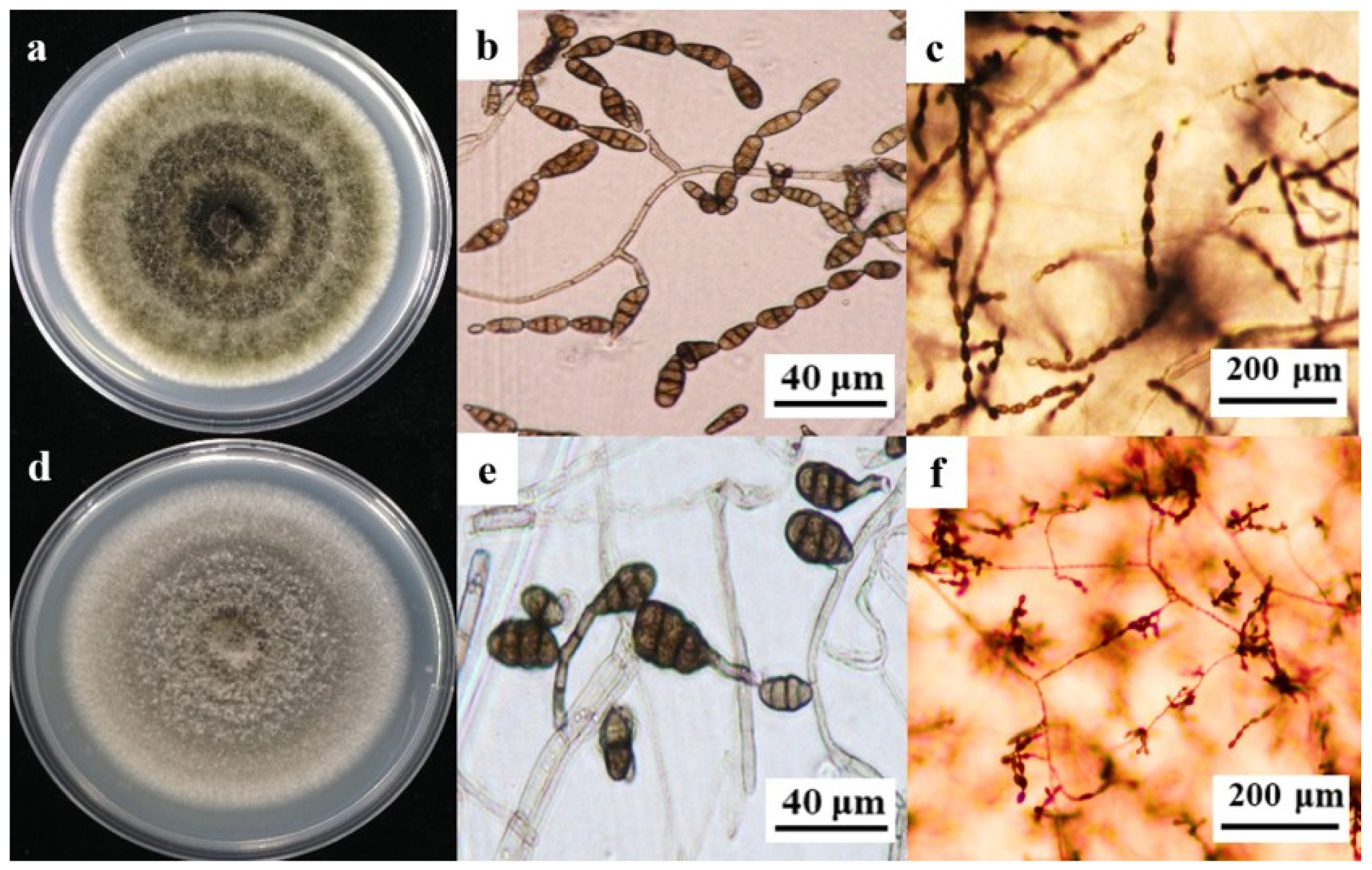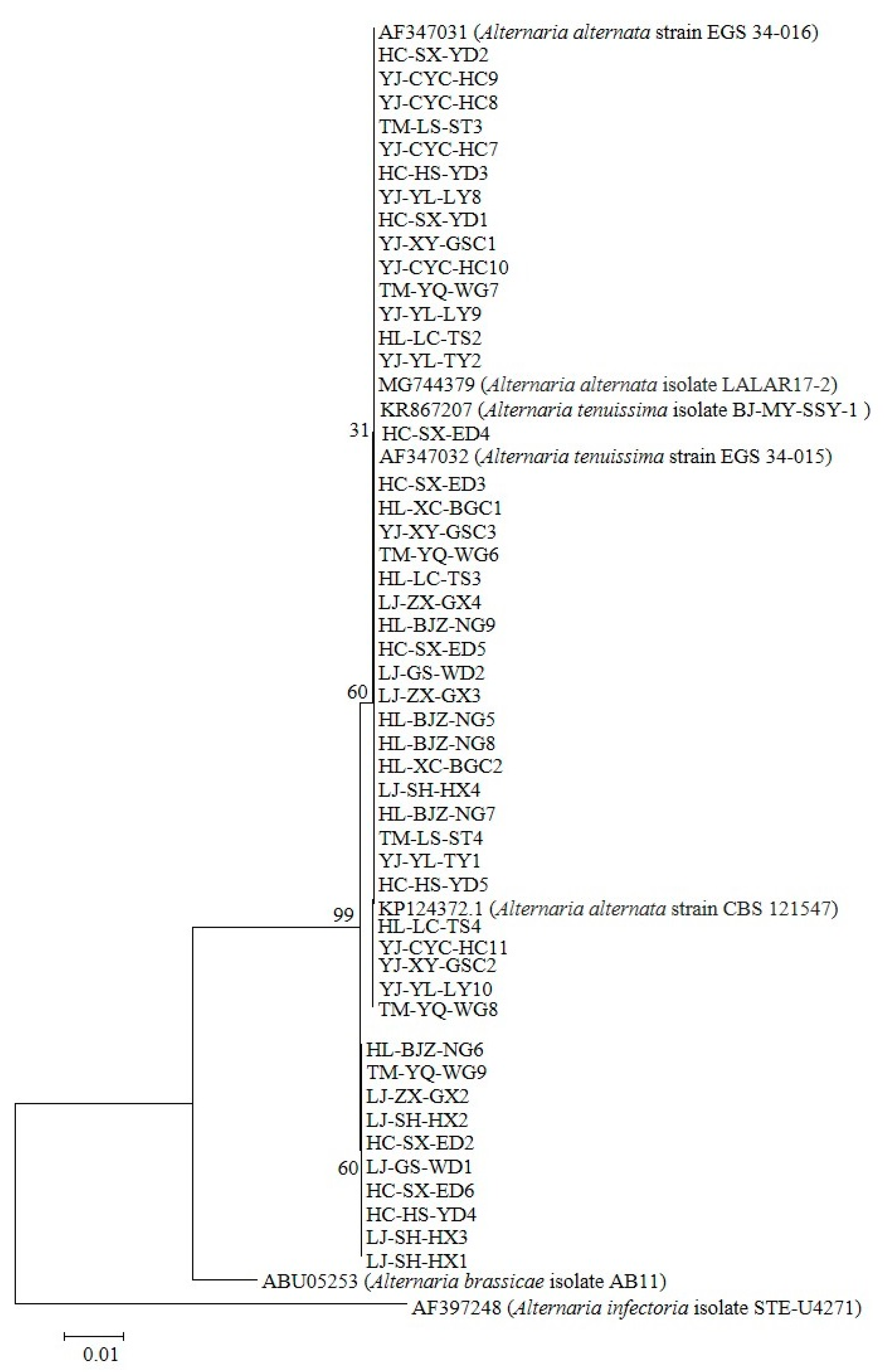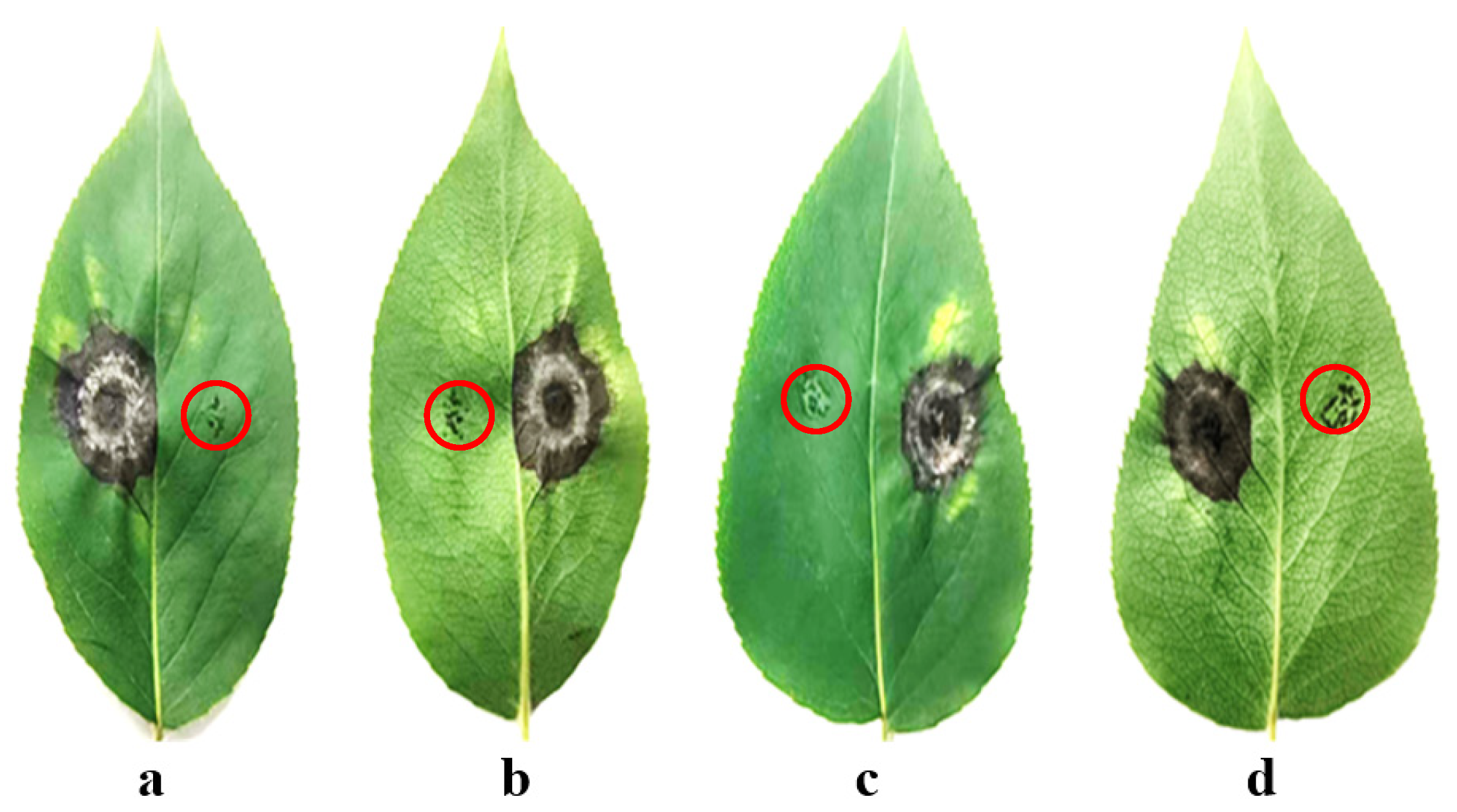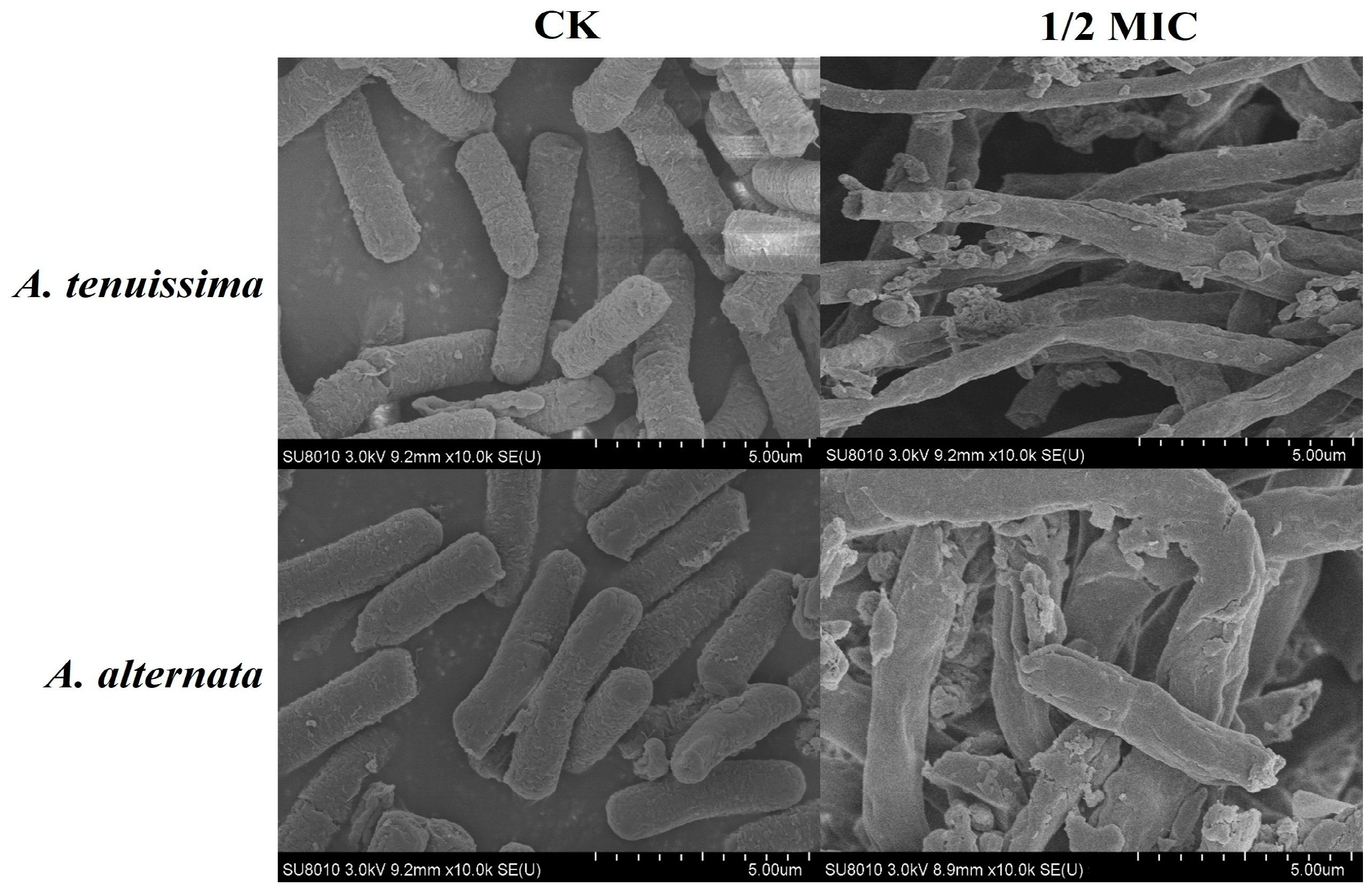Antifungal Activity of Artemisia capillaris Essential Oil Against Alternaria Species Causing Black Spot on Yanbian Pingguoli Pear in China
Abstract
1. Introduction
2. Results
2.1. Sample Collection and Isolation of Alternaria Isolates
2.2. Morphological Characterization of Alternaria Isolates
2.3. Molecular Characterization of Alternaria Isolates
2.4. Pathogenicity of Representative Alternaria Isolates
2.5. Chemical Composition of AcEO Determined by Gas Chromatography–Mass Spectrometry (GC-MS)
2.6. Antifungal Activity of the AcEO Against Alternaria spp.
3. Discussion
4. Materials and Methods
4.1. Fungal Isolation
4.2. Morphological and Molecular Characterization
4.3. Pathogenicity Tests
4.4. Extraction of AcEO and GC-MS Analysis
4.5. Antifungal Activity of the AcEO
5. Conclusions
6. Patents
Supplementary Materials
Author Contributions
Funding
Data Availability Statement
Conflicts of Interest
References
- Ma, J.N.; Wang, S.L.; Zhang, K.; Wu, Z.G.; Hattori, M.; Chen, G.L.; Ma, C.M. Chemical components and antioxidant activity of the peels of commercial apple-shaped pear (fruit of Pyrus pyrifolia cv. pingguoli). J. Food Sci. 2012, 77, C1097–C1102. [Google Scholar] [CrossRef]
- Chen, S.J.; Li, Y.C.; Bi, Y.; Yin, Y.; Ge, Y.H.; Wang, Y. Solvent effects on the ultrastructure and chemical composition of cuticular wax and its potential bioactive role against Alternaria alternata in Pingguoli pear. J. Integr. Agric. 2014, 13, 1137–1145. [Google Scholar] [CrossRef]
- Dai, J.; Hu, Y.; Si, Q.; Gu, Y.F.; Xiao, Z.Q.; Ge, Q.; Sha, R.Y. Antioxidant and hypoglycemic activity of sequentially extracted fractions from Pingguoli pear fermentation broth and identification of bioactive compounds. Molecules 2022, 27, 6077. [Google Scholar] [CrossRef]
- Li, Y.C.; Bi, Y.; Cao, J.K. Method for extraction, isolation and bioassay of antifungal compounds from Pyrus pyrifolia cv Pingguoli. J. Gansu Agric. Univ. 1999, 4, 354–357. (In Chinese) [Google Scholar]
- Li, Y.C.; Bi, Y. Extraction, isolation and identification of preformed antifungal compounds from the peel of Pingguoli pear. Sci. Technol. Food Ind. 2006, 2, 49–52. (In Chinese) [Google Scholar]
- Prusky, D. Pathogen quiescence in postharvest diseases. Annu Rev. Phytopathol. 1996, 34, 413–434. [Google Scholar] [CrossRef] [PubMed]
- Li, Y.C.; Bi, Y. Histopathological study on latent infection of Alternaria sp. in Pyrus bretchneideri. J. Gansu Agric. Univ. 2005, 4, 516–520. (In Chinese) [Google Scholar]
- Adachi, Y.; Tsuge, T. Coinfection by different isolates of Alternaria alternata in single black spot lesions of Japanese pear leaves. Phytopathology 1994, 84, 447–451. [Google Scholar] [CrossRef]
- Tanahashi, M.; Nakano, T.; Akamatsu, H.; Kodama, M.; Otani, H.; Osaki-Oka, K. Alternaria alternata apple pathotype (A. mali) causes black spot of European pear. Eur. J. Plant Pathol. 2016, 145, 787–795. [Google Scholar] [CrossRef]
- Itai, A.; Igori, T.; Fujita, N.; Egusa, M.; Kodama, M.; Murayama, H. Ethylene analog and 1-methylcyclopropene enhance black spot disease development in Pyrus pyrifolia Nakai. Hortscience 2012, 47, 228–231. [Google Scholar] [CrossRef]
- Zhang, P.F.; Zhai, L.F.; Zhang, X.K.; Huang, X.Z.; Hong, N.; Xu, W.X.; Wang, G.P. Characterization of Colletotrichum fructicola, a new causal agent of leaf black spot disease of sandy pear (Pyrus pyrifolia). Eur. J. Plant Pathol. 2015, 143, 651–662. [Google Scholar] [CrossRef]
- Song, B.; Xu, B.Q.; Zhu, X.F.; He, T.M. Genomic analysis of Alternaria alternata, the causal agent of black spot disease in Korla fragrant pears (Pyrus sinkiangensis Yü) in China. Can. J. Plant Sci. 2025, 105, 1–14. [Google Scholar] [CrossRef]
- Aichinger, G.; Grgic, D.; Beisl, J.; Crudo, F.; Warth, B.; Varga, E.; Marko, D. N-acetyl cysteine alters the genotoxic and estrogenic properties of Alternaria toxins in naturally occurring mixtures. Emerg. Contam. 2022, 8, 30–38. [Google Scholar] [CrossRef]
- Guerreiro, B.; Ventura, C.; Louro, H.; Silva, M.J. P01-05 Investigating the genotoxic effects of the Alternaria toxin tenuazonic acid in human cells. Toxicol. Lett. 2024, 399, S73–S74. [Google Scholar] [CrossRef]
- Jyotsna, B.; Patil, S.; Surya Prakash, Y.; Rathnagiri, P.; Kavi Kishor, P.B.; Jalaja, N. Essential oils from plant resources as potent insecticides and repellents: Current status and future perspectives. Biocatal. Agric. Biotechnol. 2024, 61, 103395. [Google Scholar] [CrossRef]
- Costa, W.K.; da Cruz, R.C.D.; Carvalho, K.D.; de Souza, I.A.; Correia, M.T.D.; de Oliveira, A.M.; da Silva, M.V. Insecticidal activity of essential oil from leaves of Eugenia stipitata McVaugh against Aedes aegypti. Parasitol. Int. 2024, 98, 102820. [Google Scholar] [CrossRef]
- Becer, E.; Altundag, E.M.; Güran, M.; Vatansever, H.S.; Ustürk, S.; Hanoglu, D.Y.; Baser, K.H.C. Composition and antibacterial, anti-inflammatory, antioxidant, and anticancer activities of Rosmarinus officinalis L. essential oil. S. Afr. J. Bot. 2023, 160, 437–445. [Google Scholar] [CrossRef]
- Lee, T.H.Y.; Yeom, W.; Kim, H.; Beuchat, L.R.; Ryu, J.H. Influence of diluent on antimicrobial activity of cinnamon bark essential oil vapor against Staphylococcus aureus and Salmonella enterica on a laboratory medium and beef jerky. Food Microbiol. 2023, 115, 104335. [Google Scholar] [CrossRef]
- Pophof, B.; Stange, G.; Abrell, L. Volatile organic compounds as signals in a plant-herbivore system: Electrophysiological responses in olfactory sensilla of the moth Cactoblastis cactorum. Chem. Senses 2005, 30, 51–68. [Google Scholar] [CrossRef]
- Bakkali, F.; Averbeck, S.; Averbeck, D.; Idaomar, M. Biological effects of essential oils—A review. Food Chem. Toxicol. 2008, 46, 446–475. [Google Scholar] [CrossRef]
- Viteri, L.O.; Gonza’lez, M.J.; Silva, P.B.; Gomes, J.M.; Svacina, T.; Costa, L.T.M.; Valarezo, E.; Mantilla-Afanador, J.G.; Herrera, O.M.; Aguiar, R.W.S.; et al. GABA and octopamine receptors as potential targets for fumigant actions of Bursera graveolens essential oil against Callosobruchus maculatus and Callosobruchus chinensis. J. Xenobiotics 2025, 15, 1–16. [Google Scholar] [CrossRef] [PubMed]
- Perveen, K.; Bokhari, N.A.; Al-Rashid, S.A.I.; Al-Humaid, L.A. Chemical composition of essential oil of Ocimum basilicum L. and its potential in managing the Alternaria rot of tomato. J. Essent. Oil Bear. Plants 2020, 23, 1428–1437. [Google Scholar] [CrossRef]
- Kamsu, F.P.N.; Dikongue, F.J.N.; Ngouana, V.; Tchinda, E.S.; Jiogue, M.B.; Ambata, H.T.A.; Tchameni, S.N.; Sameza, M.L.; Jazet, P.M.D. Effectiveness of Massep (Ocimum gratissimum L.) essential oil and its nanoemulsion toward Sclerotium rolfsii, Phytophthora infestans and Alternaria solani, pathogens associated with tomato rot diseases. Biocatal. Agric. Biotechnol. 2023, 47, 102591. [Google Scholar] [CrossRef]
- Chen, Y.Y.; Zhang, Y.D.; Wang, L.; Li, M.Q.; Wang, Y.; Liang, J.; Wang, D.L.; Zhang, H.W. Investigating the antifungal mechanism of Artemisia argyi essential oil against Botrytis cinerea, Alternaria alternata, and Penicillium digitatum and its application in extending blueberry shelf life. Int. J. Food Microbiol. 2025, 439, 111262. [Google Scholar] [CrossRef]
- Chen, Y.Y.; Zhang, S.H.; Qu, L.P. The protective effect of Artemisia capillaris Thunb. extract against UVB-induced apoptosis and inflammation through inhibiting the cGAS/STING pathway. J. Photochem. Photobiol. B Biol. 2024, 258, 112989. [Google Scholar] [CrossRef] [PubMed]
- Cha, J.D.; Jeong, M.R.; Jeong, S.I.; Moon, S.E.; Kim, J.Y.; Kil, B.S.; Song, Y.H. Chemical composition and antimicrobial activity of the essential oils of Artemisia scoparia and A. capillaris. Planta Med. 2005, 71, 186–190. [Google Scholar] [CrossRef]
- Simmons, E.G. Alternaria themes and variations. Mycotaxon 1995, 55, 55–163. [Google Scholar] [CrossRef]
- Singh, K.; Deepa, N.; Chauhan, S.; Tandon, S.; Verma, R.S.; Singh, A. Antifungal action of 1,8 cineole, a major component of Eucalyptus globulus essential oil against Alternaria tenuissima via overproduction of reactive oxygen species and downregulation of virulence and ergosterol biosynthetic genes. Ind. Crop Prod. 2024, 214, 118580. [Google Scholar] [CrossRef]
- Chen, X.F.; Teng, L.P.; Dan, H.X.; Xiong, R.C. Occurrence of black leaf spot caused by Alternaria alternata on Korla fragrant pear in Xinjiang of China. J. Plant Pathol. 2020, 102, 265. [Google Scholar] [CrossRef]
- Li, Y.C.; Bi, Y.; An, L.Z. Occurrence and latent infection of Alternaria rot of pingguoli pear (Pyrus bretschneideri Rehd. cv. Pingguoli) fruits in Gansu, China. J. Phytopathol. 2007, 155, 56–60. [Google Scholar]
- Yin, Y.; Bi, Y.; Chen, S.J.; Li, Y.C.; Wang, Y.; Ge, Y.H.; Ding, B.; Li, Y.; Zhang, Z. Chemical composition and antifungal activity of cuticular wax isolated from Asian pear fruit (cv. Pingguoli). Sci. Hortic. 2011, 129, 577–582. [Google Scholar] [CrossRef]
- Fu, Y.; Zhang, X.F.; Liu, S.J.H.; Hu, K.L.; Wu, X.H. Characterization of Alternaria species associated with black spot of strawberry in Beijing municipality of China. Can. J. Plant Pathol. 2020, 4, 235–242. [Google Scholar] [CrossRef]
- Ma, G.P.; Bao, S.W.; Zhao, J.; Sui, Y.; Wu, X.H. Morphological and molecular characterization of Alternaria species causing leaf blight on watermelon in China. Plant Dis. 2021, 105, 60–70. [Google Scholar] [CrossRef] [PubMed]
- Shi, X.J.; Zeng, K.X.; Wang, X.Y.; Liang, Z.H.; Wu, X.H. Characterization of Alternaria species causing leaf spot on Chinese cabbage in Shanxi province of China. J. Plant Pathol. 2021, 103, 283–293. [Google Scholar] [CrossRef]
- Sun, X.Z.; Wang, C.Y.; Gao, X.; Wu, X.H.; Fu, Y. Characterization of Alternaria species associated with black spot of strawberry in Dandong, China. Agronomy 2023, 13, 1014. [Google Scholar] [CrossRef]
- Masudaa, Y.; Asadaa, K.; Satohb, R.; Takadaa, K.; Kitajima, J. Capillin, a major constituent of Artemisia capillaris Thunb. flower essential oil, induces apoptosis through the mitochondrial pathway in human leukemia HL-60 cells. Phytomedicine 2015, 22, 545–552. [Google Scholar] [CrossRef]
- Liang, M.; Xiao, X.; Chen, M.; Guo, Y.; Han, W.T.; Min, Y.H.; Jiang, X.W.; Yu, W.H. Artemisia capillaris Thunb. Water extract alleviates metabolic dysfunction-associated Steatotic liver disease Disease by inhibiting miR-34a-5p to activate Sirt1-mediated hepatic lipid metabolism. J. Ethnopharmacol. 2025, 338, 119030. [Google Scholar] [CrossRef]
- Gao, Q.H.; Zhao, X.; Yin, L.; Zhang, Y.B.; Wang, B.; Wu, X.L.; Zhang, X.H.; Fu, X.Y.; Sun, W.H. The essential oil of Artemisia capillaris protects against CCl4-induced liver injury in vivo. Rev. Bras. Farmacogn. 2016, 26, 369–374. [Google Scholar] [CrossRef]
- Gadhi, M.A.; Nizamani, Z.A.; Jatoi, G.H.; Abro, M.A.; Keerio, A.U.; Poussio, G.B.; Qiu, D. In-vitro efficacy of bio-control agent and essential oils against leaf blight of chickpea caused by Alternaria alternata. Acta Ecol. Sin. 2020, 40, 166–171. [Google Scholar] [CrossRef]
- Allagui, M.B.; Moumni, M.; Romanazzi, G. Antifungal activity of thirty essential oils to control pathogenic fungi of postharvest decay. Antibiotics 2024, 13, 28. [Google Scholar] [CrossRef]
- White, T.J.; Bruns, T.; Lee, S.; Taylor, J. Amplification and direct sequencing of fungal ribosomal RNA genes for phylogenetics. PCR Protoc. 1990, 18, 315–322. [Google Scholar]
- Glass, N.L.; Donaldson, G.C. Development of primer sets designed for use with the PCR to amplify conserved genes from filamentous ascomycetes. Appl. Environ. Microbiol. 1995, 61, 1323–1330. [Google Scholar] [CrossRef]
- Thompson, J.D.; Higgins, D.G.; Gibson, T.J. Clustal W: Improving the sensitivity of progressive multiple sequence alignment through sequence weighting, position-specific gap penalties and weight matrix choice. Nucleic Acids Res. 1994, 22, 4673–4680. [Google Scholar] [CrossRef]
- Pryor, B.M.; Michailides, T.J. Morphological, pathogenic, and molecular characterization of Alternaria isolates associated with Alternaria late blight of pistachio. Phytopathology 2002, 92, 406–416. [Google Scholar] [CrossRef]
- Fu, Y. A Raw Material Steaming Device for Plant Essential Oil Production. No. CN117778103B. 9 August 2023. [Google Scholar]
- Zheng, T.Y. Study on Antifungal Mechanism of Artemisia sieversiana Essential oil on Pathogenic Fungi Causing Pingguoli pear Black Spot. Master’s Thesis, Yanbian University, Yanbian, China, 2024. [Google Scholar]
- Oses, R.; Ferrando, M.; Bruna, F.; Retamales, P.; Navarro, M.; Fernández, K.; Vera, W.; Larrazábal, M.J.; Neira, I.; Paredes, A.; et al. Exploring the bioactive potential and chemical profile of Schinus molle essential oil: An integrated in Silico and in vitro evaluation. Plants 2025, 14, 2449. [Google Scholar] [CrossRef] [PubMed]






| Geographic Districts of Yanbian | Number of Fields | Number of Alternaria Isolates | |
|---|---|---|---|
| A. tenuissima | A. alternata | ||
| Longjing County, Zhixin Town | 1 | 1 (1) a | 4 (2) |
| Longjing County, Fruit Farm | 1 | 0 (0) | 6 (2) |
| Longjing County, Shanhe Town | 1 | 1 (1) | 11 (3) |
| Helong County, Bajiazi Town | 1 | 4 (2) | 9 (3) |
| Helong County, Xicheng Town | 1 | 5 (2) | 0 (0) |
| Helong County, Longcheng Town | 1 | 3 (2) | 2 (1) |
| Tumen County, Yueqing Town | 1 | 14 (3) | 1 (1) |
| Tumen County, Liangshui Town | 1 | 4 (2) | 0 (0) |
| Yanji City, Yilan Town | 2 | 14 (4) | 3 (1) |
| Yanji City, Chaoyangchuan Town | 1 | 5 (2) | 7 (3) |
| Yanji City, Xiaoying Town | 1 | 5 (2) | 1 (1) |
| Hunchun County, Yingan Town | 3 | 11 (5) | 13 (5) |
| Total | 15 | 67 (26) | 57 (22) |
| Ratio | – | 54.0% | 46.0% |
| Alternaria Species | Isolate Number | Disease Incidence (%) [Mean ± Standard Deviation (Range)] | Disease Index [Mean ± Standard Deviation (Range)] |
|---|---|---|---|
| A. tenuissima | 26 | 71.2 ± 13.5 (51.7–100.0) a | 57.3 ± 6.9 (30.5–50.4) a * |
| A. alternata | 22 | 48.2 ± 8.6 (31.2–100.0) b | 19.8 ± 3.7 (18.2–29.5) b * |
| No. | Compound | Retention Time (min) | Molecular Formula | CAS | Relative Content (>0.05%) |
|---|---|---|---|---|---|
| 1 | Bicyclo [3.1.0]hex-2-ene | 9.68 | C10H16 | 2867-05-2 | 0.13 |
| 2 | (1R)-2,6,6-Trimethylbicyclo[3.1.1]hept-2-ene | 9.99 | C10H16 | 7785-70-8 | 1.46 |
| 3 | α-Pinene | 10.17 | C10H16 | 80-56-8 | 0.95 |
| 4 * | 2,2-Dimethyl-3-methylenebicyclo[2.2.1]heptane | 10.71 | C10H16 | 5794-04-7 | 5.03 |
| 5 | 1-Isopropyl-4-meth-ylenebicyclo[3.1.0]hexane | 11.85 | C10H16 | 3387-41-5 | 1.97 |
| 6 | Myrcene | 12.49 | C10H16 | 123-35-3 | 1.79 |
| 7 | 1-Octen-3-ol | 13.65 | C9H16O | 3391-86-4 | 1.31 |
| 8 * | Eucalyptol | 15.20 | C10H18O | 470-82-6 | 60.40 |
| 9 | Cis-3,7-Dimethyl-1,3,6-octatriene | 15.32 | C10H16 | 3338-55-4 | 1.03 |
| 10 | Crithmene | 15.75 | C10H16 | 99-85-4 | 1.96 |
| 11 | Isoterpinolene | 16.56 | C10H16 | 586-63-0 | 0.2 |
| 12 | Isothujone | 17.62 | C10H16O | 471-15-8 | 1.73 |
| 13 | Thujone | 18.06 | C10H16O | 546-80-5 | 0.46 |
| 14 | (4E,6Z)-2,6-Dimethyl-2,4,6-octatriene | 18.43 | C10H16 | 7216-56-0 | 0.84 |
| 15 * | (-)-Alcanfor | 19.30 | C10H16O | 76-22-2 | 3.86 |
| 16 | L(-)-Borneol | 20.76 | C10H18O | 464-45-9 | 2.42 |
| 17 | Terpinen-4-ol | 20.89 | C10H18O | 562-74-3 | 0.75 |
| 18 | Terpineol | 21.33 | C10H18O | 98-55-5 | 0.52 |
| 19 | (Z)-piperitol | 21.73 | C10H18O | 16721-38-3 | 0.07 |
| 20 | Capillin | 23.12 | C12H18O | 495-74-9 | 2.26 |
| 21 | 1,7,7-Trimethylbicyclo[2.2.1]hept-2-yl acetate | 24.32 | C12H20O2 | 92618-89-8 | 0.31 |
| 22 | (1S,3S,5S)-1-Isopropyl-4-methylenebicyclo[3.1.0]hexan-3-yl acetate | 24.52 | C12H20O2 | 139757-62-3 | 0.42 |
| 23 | γ-Elemene | 25.93 | C15H24 | 29873-99-2 | 0.08 |
| 24 | α-copaene | 27.48 | C15H24 | 3856-25-5 | 0.09 |
| 25 * | β-copaene | 29.15 | C15H24 | 18252-44-3 | 3.25 |
| 26 | (-)-Isogermacrene D | 29.86 | C15H24 | 317819-80-0 | 0.10 |
| 27 | (-)-Caryophyllene | 30.11 | C15H24 | 87-44-5 | 0.14 |
| 28 | α-caryophyllene | 30.27 | C15H24 | 6753-98-6 | 0.10 |
| 29 | (-)-Germacrene D | 31.25 | C15H24 | 23986-74-5 | 1.64 |
| 30 | 1,2,3,4,4a,5,6,7-octahydro-4a,5-dimethyl-3-(1-methylethenyl)-1-Naphthalenol | 31.35 | C15H24O | 61847-19-6 | 0.16 |
| 31 | bicyclogermacrene | 31.60 | C15H24 | 24703-35-3 | 0.05 |
| 32 | ε-Muurolene | 31.75 | C15H24 | 30021-46-6 | 0.07 |
| 33 | δ-Cadinene | 32.34 | C15H24 | 483-76-1 | 0.39 |
| 34 | α-Panasinsene | 33.11 | C15H24 | 56633-28-4 | 0.64 |
| 35 | (+)-Phyllocladene | 34.50 | C20H32 | 469-86-3 | 1.27 |
| 36 | Gitoxigenin | 35.71 | C23H34O5 | 545-26-6 | 0.21 |
| 37 | Muurolol | 36.29 | C15H26O | 19912-62-0 | 0.17 |
| 38 | Neointermedeol | 36.90 | C15H26O | 5945-72-2 | 0.53 |
| 39 | cis-p-mentha-2,8-dien-1-ol | 37.50 | C10H16O | 425394-92-9 | 0.14 |
| 40 | Bi-1-cycloocten-1-yl | 42.04 | C16H26 | 61468-42-6 | 0.55 |
Disclaimer/Publisher’s Note: The statements, opinions and data contained in all publications are solely those of the individual author(s) and contributor(s) and not of MDPI and/or the editor(s). MDPI and/or the editor(s) disclaim responsibility for any injury to people or property resulting from any ideas, methods, instructions or products referred to in the content. |
© 2025 by the authors. Licensee MDPI, Basel, Switzerland. This article is an open access article distributed under the terms and conditions of the Creative Commons Attribution (CC BY) license (https://creativecommons.org/licenses/by/4.0/).
Share and Cite
Kou, Z.-X.; Dang, Y.; Liu, L.; Wu, X.-H.; Fu, Y. Antifungal Activity of Artemisia capillaris Essential Oil Against Alternaria Species Causing Black Spot on Yanbian Pingguoli Pear in China. Plants 2025, 14, 3146. https://doi.org/10.3390/plants14203146
Kou Z-X, Dang Y, Liu L, Wu X-H, Fu Y. Antifungal Activity of Artemisia capillaris Essential Oil Against Alternaria Species Causing Black Spot on Yanbian Pingguoli Pear in China. Plants. 2025; 14(20):3146. https://doi.org/10.3390/plants14203146
Chicago/Turabian StyleKou, Zu-Xin, Yue Dang, Li Liu, Xue-Hong Wu, and Yu Fu. 2025. "Antifungal Activity of Artemisia capillaris Essential Oil Against Alternaria Species Causing Black Spot on Yanbian Pingguoli Pear in China" Plants 14, no. 20: 3146. https://doi.org/10.3390/plants14203146
APA StyleKou, Z.-X., Dang, Y., Liu, L., Wu, X.-H., & Fu, Y. (2025). Antifungal Activity of Artemisia capillaris Essential Oil Against Alternaria Species Causing Black Spot on Yanbian Pingguoli Pear in China. Plants, 14(20), 3146. https://doi.org/10.3390/plants14203146





